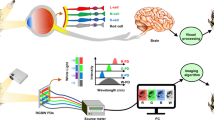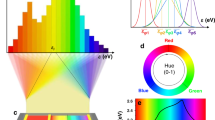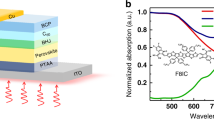Abstract
Wavelength-selective light detection is crucial for many applications, including imaging and machine vision. Narrowband spectral responses are required for colour discrimination, and current systems use broadband photodiodes combined with optical filters. This approach increases the architectural complexity and limits the quality of colour sensing. Here we report a method for tuning the spectral response to give filterless, narrowband red, green and blue photodiodes. The devices have simple planar junction architectures with the photoactive layer being a solution-processed mixture of either an organohalide perovskite or lead halide semiconductor and an organic (macro)molecule. The organic (macro)molecules modify the optical and electrical properties of the photodiode and facilitate charge collection narrowing of the device's external quantum efficiency. These red, green and blue photodiodes all possess full-width at half-maxima of <100 nm and performance metrics suitable for many imaging applications.
This is a preview of subscription content, access via your institution
Access options
Subscribe to this journal
Receive 12 print issues and online access
$209.00 per year
only $17.42 per issue
Buy this article
- Purchase on Springer Link
- Instant access to full article PDF
Prices may be subject to local taxes which are calculated during checkout





Similar content being viewed by others
References
Konstantatos, G. & Sargent, E. H. Nanostructured materials for photon detection. Nature Nanotech. 5, 391–400 (2010).
Gong, X. et al. High-detectivity polymer photodetectors with spectral response from 300 nm to 1450 nm. Science 325, 1665–1667 (2009).
Konstantatos, G., Clifford, J., Levina, L. & Sargent, E. H. Sensitive solution-processed visible-wavelength photodetectors. Nature Photon. 1, 531–534 (2007).
Baeg, K. J., Binda, M., Natali, D., Caironi, M. & Noh, Y. Y. Organic light detectors: photodiodes and phototransistors. Adv. Mater. 25, 4267–4295 (2013).
Clifford, J. P. et al. Fast, sensitive and spectrally tuneable colloidal-quantum-dot photodetectors. Nature Nanotech. 4, 40–44 (2008).
Guo, F., Xiao, Z. & Huang, J. Fullerene photodetectors with a linear dynamic range of 90 dB enabled by a cross-linkable buffer layer. Adv. Opt. Mater. 1, 289–294 (2013).
Armin, A. et al. Thick junction broadband organic photodiodes. Laser Photon. Rev. 8, 924–932 (2014).
Guo, F. et al. A nanocomposite ultraviolet photodetector based on interfacial trap-controlled charge injection. Nature Nanotech. 7, 798–802 (2012).
Nishiwaki, S., Nakamura, T., Hiramoto, M., Fujii, T. & Suzuki, M. Efficient colour splitters for high-pixel-density image sensors. Nature Photon. 7, 240–246 (2013).
Armin, A., Jansen-van Vuuren, R. D., Kopidakis, N., Burn, P. L. & Meredith, P. Narrowband light detection via internal quantum efficiency manipulation of organic photodiodes. Nature Commun. 6, 6343 (2015).
Lukac, R. Single-sensor imaging in consumer digital cameras: a survey of recent advances and future directions. J. Real-time Image Proc. 1, 45–52 (2006).
Park, H. et al. Filter-free image sensor pixels comprising silicon nanowires with selective color absorption. Nano Lett. 14, 1804–1809 (2014).
Xu, T., Wu, Y.-K., Luo, X. & Guo, L. J. Plasmonic nanoresonators for high-resolution colour filtering and spectral imaging. Nature Commun. 1, 59 (2010).
Yokogawa, S., Burgos, S. P. & Atwater, H. A. Plasmonic color filters for CMOS image sensor applications. Nano Lett. 12, 4349–4354 (2012).
Gautam, V., Bag, M. & Narayan, K. Single-pixel, single-layer polymer device as a tricolor sensor with signals mimicking natural photoreceptors. J. Am. Chem. Soc. 133, 17942–17949 (2011).
Higashi, Y., Kim, K.-S., Jeon, H.-G. & Ichikawa, M. Enhancing spectral contrast in organic red-light photodetectors based on a light-absorbing and exciton-blocking layered system. J. Appl. Phys. 108, 034502 (2010).
Lim, S. -J. et al. Organic-on-silicon complementary metal–oxide–semiconductor colour image sensors. Sci. Rep. 5, 7708 (2015).
Lee, K.-H. et al. Dynamic characterization of green-sensitive organic photodetectors using non-fullerene small molecules: frequency response based on the molecular structure. J. Phys. Chem. C 118, 13424–13431 (2014).
Lyons, D. M. et al. Narrow band green organic photodiodes for imaging. Org. Electron. 15, 2903–2911 (2014).
Tan, Z.-K. et al. Bright light-emitting diodes based on organometal halide perovskite. Nature Nanotech. 9, 687–692 (2014).
Kim, Y. H. et al. Multicolored organic/inorganic hybrid perovskite light-emitting diodes. Adv. Mater. 27, 1248–1254 (2014).
Kulkarni, S. A. et al. Band-gap tuning of lead halide perovskites using a sequential deposition process. J. Mater. Chem. A 2, 9221–9225 (2014).
Lin, Q., Armin, A., Lyons, D. M., Burn, P. L. & Meredith, P. Low noise, IR-blind organohalide perovskite photodiodes for visible light detection and imaging. Adv. Mater. 27, 1969–2120 (2015).
Benson-Smith, J. J. et al. Formation of a ground-state charge-transfer complex in polyfluorene/[6, 6]-phenyl-C61 butyric acid methyl ester (PCBM) blend films and its role in the function of polymer/PCBM solar cells. Adv. Funct. Mater. 17, 451–457 (2007).
Green, M. A., Ho-Baillie, A. & Snaith, H. J. The emergence of perovskite solar cells. Nature Photon. 8, 506–514 (2014).
Xiao, Z. et al. Giant switchable photovoltaic effect in organometal trihalide perovskite devices. Nature Mater. 14, 193–198 (2014).
Zhou, H. et al. Interface engineering of highly efficient perovskite solar cells. Science 345, 542–546 (2014).
Jeon, N. J. et al. Compositional engineering of perovskite materials for high-performance solar cells. Nature 517, 476–480 (2015).
Stranks, S. D. et al. Electron–hole diffusion lengths exceeding 1 micrometer in an organometal trihalide perovskite absorber. Science 342, 341–344 (2013).
Xing, G. et al. Long-range balanced electron- and hole-transport lengths in organic–inorganic CH3NH3PbI3 . Science 342, 344–347 (2013).
Lin, Q., Armin, A., Nagiri, R. C. R., Burn, P. L. & Meredith, P. Electro-optics of perovskite solar cells. Nature Photon. 9, 106–112 (2014).
Jeon, N. J. et al. Solvent engineering for high-performance inorganic–organic hybrid perovskite solar cells. Nature Mater. 13, 897–903 (2014).
Xiao, M. et al. A fast deposition–crystallization procedure for highly efficient lead iodide perovskite thin-film solar cells. Angew. Chem. Int. Ed. 126, 10056–10061 (2014).
Dou, L. et al. Solution-processed hybrid perovskite photodetectors with high detectivity. Nature Commun. 5, 5404 (2014).
Hu, X. et al. High-performance flexible broadband photodetector based on organolead halide perovskite. Adv. Funct. Mater. 24, 7373–7380 (2014).
Xia, H.-R., Li, J., Sun, W.-T. & Peng, L.-M. Organohalide lead perovskite based photodetectors with much enhanced performance. Chem. Commun. 50, 13695–13697 (2014).
Lee, Y. et al. High-performance perovskite–graphene hybrid photodetector. Adv. Mater. 27, 41–46 (2015).
Dong, R. et al. High gain and low-driving-voltage photodetectors based on organolead triiodide perovskites. Adv. Mater. 27, 1912–1918 (2015).
Li, D., Dong, G., Li, W. & Wang, L. High performance organic–inorganic perovskite–optocoupler based on low-voltage and fast response perovskite compound photodetector. Sci. Rep. 5, 7902 (2015).
Sutherland, B. R. et al. Sensitive, fast, and stable perovskite photodetectors exploiting interface engineering. ACS Photon. 2, 1117–1123 (2015).
Grancini, G. et al. Role of microstructure in the electron-hole interaction of hybrid lead halide perovskites. Nature Photon. http://dx.doi.org/10.1038/nphoton.2015.151 (2015).
Armin, A. et al. Balanced carrier mobilities: not a necessary condition for high-efficiency thin organic solar cells as determined by MIS-CELIV. Adv. Energy Mater. 4, 1300954 (2014).
Burkhard, G. F., Hoke, E. T. & McGehee, M. D. Accounting for interference, scattering, and electrode absorption to make accurate internal quantum efficiency measurements in organic and other thin solar cells. Adv. Mater. 22, 3293–3297 (2010).
Koster, L., Kemerink, M., Wienk, M. M., Maturová, K. & Janssen, R. A. Quantifying bimolecular recombination losses in organic bulk heterojunction solar cells. Adv. Mater. 23, 1670–1674 (2011).
Stolterfoht, M. et al. Photocarrier drift distance in organic solar cells and photodetectors. Sci. Rep. 5, 9949 (2015).
Leijtens, T. et al. Electronic properties of meso-superstructured and planar organometal halide perovskite films: charge trapping, photodoping, and carrier mobility. ACS Nano 8, 7147–7155 (2014).
Fang, Y. & Huang, J. Resolving weak light of sub-picowatt per square centimeter by hybrid perovskite photodetectors enabled by noise reduction. Adv. Mater. 27, 2804–2810 (2015).
Acknowledgements
P.L.B. is a UQ Vice Chancellor's Research Focussed Fellow and P.M. is an ARC Discovery Outstanding Researcher Award Fellow. Q.L. is supported by an International Postgraduate Research Scholarship (IPRS). This work was performed in part at the Queensland node of the Australian National Fabrication Facility (ANFF), a company established under the National Collaborative Research Infrastructure Strategy to provide nano and micro fabrication facilities for Australia's researchers. This Program has also been supported by the Australian Government through the Australian Renewable Energy Agency (ARENA) Australian Centre for Advanced Photovoltaics. Responsibility for the views, information or advice expressed herein is not accepted by the Australian Government.
Author information
Authors and Affiliations
Contributions
Q.L. characterized the perovskite films and fabricated the devices. Q.L. and A.A. tested the devices and all authors interpreted the data. P.L.B. and P.M. supervised the project. All authors contributed to preparation of the manuscript. All authors have given approval to the final version of the manuscript.
Corresponding authors
Ethics declarations
Competing interests
The authors declare no competing financial interests.
Supplementary information
Supplementary information
Supplementary information (PDF 1207 kb)
Rights and permissions
About this article
Cite this article
Lin, Q., Armin, A., Burn, P. et al. Filterless narrowband visible photodetectors. Nature Photon 9, 687–694 (2015). https://doi.org/10.1038/nphoton.2015.175
Received:
Accepted:
Published:
Issue Date:
DOI: https://doi.org/10.1038/nphoton.2015.175
This article is cited by
-
Broadband long-wave infrared high-absorption of active materials through hybrid plasmonic resonance modes
Discover Nano (2023)
-
Perovskite-based color camera inspired by human visual cells
Light: Science & Applications (2023)
-
Effect of ageing on electrical properties of Fe-doped CuO thin films deposited by spin coating technique
Indian Journal of Physics (2023)
-
Perovskite films with gradient bandgap for self-powered multiband photodetectors and spectrometers
Nano Research (2023)
-
Multifunctional Perovskite Photodetectors: From Molecular-Scale Crystal Structure Design to Micro/Nano-scale Morphology Manipulation
Nano-Micro Letters (2023)



